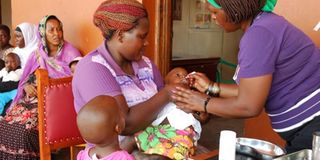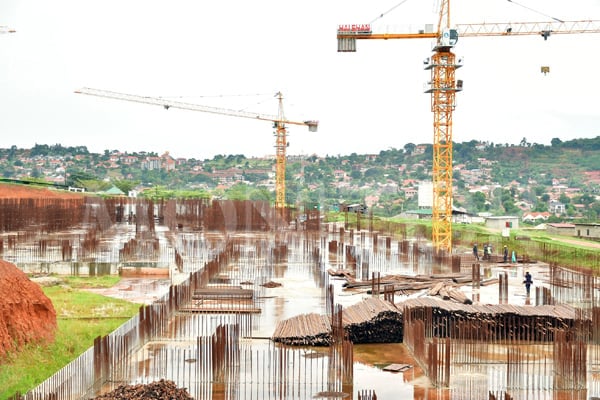How America spends aid in Uganda

Vaccination. A health worker gives an oral Polio vaccine to a child in Masaka District during a recent Mass immunisation exercise. PHOTO BY MARTINS E. SSEKWEYAMA
What you need to know:
Time to account. The United States government, on behalf of the American people, pumped into Uganda almost a billion dollars during the course of this financial year. Stephen Kafeero studied the report and breaks down where the dollars have gone.
The United States of America has between October last year and September this year availed $840.4 million (Shs2.9 trillion) for health, justice, education, stability and ensuring the prosperity of Ugandans. This is contained in the 55-page “Report to the Ugandan people”, that the US Embassy in Kampala released this week.
Uganda’s health sector is the biggest beneficiary of US aid spend, with approximately $488.3 million or Shs1.7 trillion pumped in between October last year and September this year. This support makes the US the largest single provider of health assistance to Uganda.
By dedicating much of their support to the health sector, the US government says their aim is to reduce the threats of infectious diseases like HIV, tuberculosis, and malaria, to improve the health of mothers and newborn children.
The report notes that US funded programmes in the sector are providing life-saving medicines, empowering girls, saving mothers, and allowing Ugandans to live longer, more productive lives.
The US classifies Uganda’s stability as very important to its work in the country and this perhaps explains why it is the second largest funded priority. In the last financial year, the US government spent $279.6 million or Shs951.2 billion in assistance to guarantee a stable Uganda.
Some of the resources were, according to the report, spent on efforts to professionalise Uganda People’s Defence Force (UPDF). For example, the US provided training in human rights and peacekeeping methods to more than 5,000 UPDF soldiers.
Other areas “to ensure stability” that the US invested in over the year included programmes that promote peaceful dialogue as a means of avoiding conflict and violence. Through legal aid programmes, the US has, for example, helped families to peacefully resolve land disputes and other conflicts, especially in northern Uganda which was ravaged by more than two decades of civil war.
The number of refugees entering to Uganda increases every year. During the period under review, the US government contributed $126.5 million or 453.8 billion to assist refugees in Uganda and vulnerable populations in Karamoja sub-region. That figure is likely to increase in the next financial year.
In fostering the Global Health Security Agenda, the US says it has supported Uganda to develop world-class capabilities to detect and control infectious disease outbreaks such as ebola, yellow fever, and cholera. This too, is part of US support for a stable Uganda.
Health officials are supported with tools and equipped with skills to respond in the case of a health emergency.
With assistance from CDC, USAID, and other US government partners, the US government says it is helping to improve Uganda’s preparedness and emergency management capacity by establishing Uganda’s Public Health Emergency Operation Center and training workers to detect diseases before they spread.
The US government, according to report, invests in activities aimed at making Ugandans wealthier. The US spent $47.5m (Shs 161.7b) in support of such activities. In the report, the US government says $68.8 million worth of coffee was sold by farmers associated with one of its flagship economic programmes, the Feed the Future programme in the financial year 2015/2016.
The assistance, the report notes, seeks to generate a stronger economic climate, reduce poverty, and expand trade and investment opportunities. The activities include efforts to add value to the production chains of maize, coffee, and beans, as well as training programmes and microfinance projects for entrepreneurs.
“We encourage increased trade between Uganda and the United States through the African Growth and Opportunity Act, which helps domestic exporters take advantage of trade preferences and provide greater access to US markets,” the report notes.
The US also funds conservation activities which are helping to combat illegal trafficking and environmental destruction, in an effort to protect Uganda’s abundant natural biodiversity.
With one of the youngest populations in the world, the US is supporting efforts in the country to build what it terms as an inclusive, educated, and empowered Uganda through funding of $14.7million (Shs50 billion).
“US-funded programmes in Uganda aim to ensure all voices, especially those of women and youth, are fully represented in all aspects of life and development. The activities we support seek to ensure that every Ugandan benefits from the country’s economic growth, receives a quality education, and has the opportunity to contribute to society,” the report further notes.
Efforts by the US government to promote a more just and democratic Uganda receive the least funding of the five priority areas the US government funds. It is, however, significant given that some of the development partners find this sector unappealing. The US government, according to the report dedicates $10.3 million (Shs 35 billion).
The programmes facilitated aim at building “the capacity of civil society actors to advocate on behalf of their fellow Ugandans, especially those who traditionally face neglect or discrimination – such as women, LGBT individuals, ethnic and religious minorities, and persons with disabilities.”
By training judges and others activists to protect human rights, the US government says it aims at supporting efforts to increase government transparency, and combat corruption.
US versus China

US ambassador to Uganda Deborah Malac
In her foreword to the report, Deborah Malac says: “The objective of our (aid) programmes is simple: we want to help Ugandans create a healthy, prosperous and stable country with just and democratic governance, which will in turn produce an inclusive, educated, and empowered population,” she says.
From Ms Malac’s statement, one can quickly decipher the key difference between the approaches of the US and China, the country that is pushing the US hardest in the race to dominate and influence the world, as far as their aid priorities are concerned.
China has on the other hand mostly invested in brick and mortar, with the Asian giant bankrolling giant projects like Isimba and Karuma dams, roads, and the planned construction of the Standard Gauge Railway. China is also funding the expansion of Entebbe airport, and has built the President’s Office building and a hospital in Naguru, among other projects.
The European Union, the other giant donor to Uganda, has on the other hand focused on transport infrastructure, food security and agriculture, value chains and green economy, and good governance.
To understand the differences in approaches to aid between the US, EU and China, one may need to look deeper into those donor countries. The US and the EU countries are democracies for which human rights and governance issues matter more than they do to China, a monolithic state that has been controlled by the Communist party for almost 80 years.
China, therefore, is primarily keen to create and maintain good relations with developing countries like Uganda, with which they may then trade in their quest to access raw materials and eventually markets.
The US and EU, even when they too have over the centuries, since the ages of slavery and colonial rule, sought to control the poorer countries to access raw materials and eventually get markets, now find themselves pressured by pro-democracy lobbies within their backyards to push the dictates of human rights and good governances in other countries.
The absence of such lobbies in China allows the Chinese government the lee-way that its rivals don’t have – to remain unconcerned with the internal politics of its client states like Uganda. The Americans and Europeans, even when their governments have had interests to pursue within poor countries like Uganda that may run counter to pursuing human rights and good governance, will always at least pay lip to the cause.
Ms Malac says her government believes by channelling America’s aid to Ugandans in the five areas identified above, Ugandans will “live up to their full potential” and “this is the future that all Ugandans – regardless of age, gender, religion, ethnicity, sexual orientation, or political beliefs – deserve.”
The mantra of America’s aid, as captured in the report, is to invest in human development as opposed to investing in physical things as China favours.
Uganda, however, gets a lot more aid from China, its biggest bilateral donor which, according to the ministry of Finance, had lent to Uganda $1.099 billion (Shs3.8 trillion) as of June 2017, while the US does not feature in the top 15 countries that Uganda owes money.




